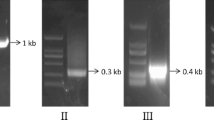Abstract
Pentose phosphate pathway (PPP) composed of two functionally-connected phases, the oxidative and non-oxidative phase. Both phases catalysed by a series of enzymes. Transketolase is one of key enzymes of non-oxidative phase in which transfer two carbon units from fructose-6-phosphate to erythrose-4-phosphate and convert glyceraldehyde-3-phosphate to xylulose-5-phosphate. In plant, erythrose-4-phosphate enters the shikimate pathway which is produces many secondary metabolites such as aromatic amino acids, flavonoids, lignin. Although transketolase in plant system is important, study of this enzyme is still limited. Until to date, TKT genes had been isolated only from seven plants species, thus, the aim of present study to isolate, study the similarity and phylogeny of transketolase from sugarcane. Unlike bacteria, fungal and animal, PPP is complete in the cytosol and all enzymes are found cytosolic. However, in plant, the oxidative phase found localised in the cytosol but the sub localisation for non-oxidative phase might be restricted to plastid. Thus, this study was conducted to determine subcellular localization of sugarcane transketolase. The isolation of sugarcane TKT was done by reverse transcription polymerase chain reaction, followed by cloning into pJET1.2 vector and sequencing. This study has isolated 2,327 bp length of sugarcane TKT. The molecular phylogenetic tree analysis found that transketolase from sugarcane and Zea mays in one group. Classification analysis found that both plants showed closer relationship due to both plants in the same taxon i.e. family Poaceae. Target P 1.1 and Chloro P predicted that the compartmentation of sugarcane transketolase is localised in the chloroplast which is 85 amino acids are plant plastid target sequence. This led to conclusion that the PPP is incomplete in the cytosol of sugarcane. This study also found that the similarity sequence of sugarcane TKT closely related with the taxonomy plants.







Similar content being viewed by others
Abbreviations
- PPP:
-
Pentose phosphate pathway
- TKT:
-
Transketolase
- RT-PCR:
-
Reverse transcription polymerase chain reaction
- DNA:
-
Deoxyribonucleic acid
- PCR:
-
Polymerase chain reaction
- cDNA:
-
Complementary deoxyribonucleic acid
- LB:
-
Luria–Bertani
- IPTG:
-
Isopropyl-b-d-thiogalactopyranoside
- rpm:
-
Revolutions per minute
- SDS-PAGE:
-
Sodium dodecyl sulphate–polyacrylamide gel electrophoresis
References
Bernacchia G, Schwall G, Lottspeich F, Salamini F, Bartels D (1995) EMBO J 14(3):610–618
Boddey RM (1995) Crit Rev Plant Sci 14:263–279
Caillau M, Quick WP (2005) Plant J 43:1–16
Debnam PM, Emes MJ (1999) Plant J 38(1):49–59
Debnam PM, Fernie AR, Leisse A, Golding A, Bowsher CG, Grimshaw C, Knight JS, Emes MJ (2004) Plant J 38(1):49–59
Dennis DT (1997) American Society of Plant Physiologists, Rockville, MD: 630–675
Doyle JJ, Gaut BS (2000) Plant Mol Biol 42(1):1–23
Eicks M, Maurino V, Knappe S, Flügge UI, Fischer K (2002) Plant Physiol 128:512–522
Emes MJ, Fowler MW (1979) Planta 144:249–253
Fischer K, Kammerer B, Gutensohn M, Arbinger B, Weber A, Häusler R, Flügge UI (1997) Plant cell 9:453–462
Flechner A, Dressen U, Westhoff P, Henze K, Schnarrenberger C, Martin W (1996) Plant Mol Biol 32(3):475–484
Fliege R, Flügge UI, Werdan K, Heldt HW (1978) Biochim Biophys Acta 502:232–242
Flügge UI, Fischer K, Gross A, Sebald W, Lottspeich F, Echerskorn C (1989) EMBO J 8:39–46
Flügge UI, Häusler RE, Ludewig F, Fischer K (2002) Physiol Plant 118:475–482
Fullam E, Pojer F, Bergfors T, Jones TA, Cole T (2012) Open Biol 2(1):11–26
Garnier T, Eiglmeier K, Camus JC, Medina N, Mansoor H, Pryor M, Duthoy S, Grondin S, Lacroix C, Monsempe C, Simon S, Harris B, Atkin R, Doggett J, Mayes R, Keating L, Wheeler PR, Parkhill J, Barrell BG, Cole ST, Gordon SV, Hewinson RG (2003) Proc Natl Acad Sci USA 100(13):7877–7882
Ghassemian M, Waner D, Tchieu J, Gribskov M, Schroeder JI (2001) Trends Plant Sci 6:448–449
Gerhardt S, Echt S, Busch M, Freigang J, Auerbach G, Bader G, Martin WF, Bacher A, Huber R, Fischer M (2003) Plant Physiol 132(4):1941–1949
Joshi S, Singh AR, Kumar A, Misra PC, Siddiqi MI, Saxena JK (2008) Mol Biochem Parasitol 160(1):32–41
Kammerer B, Fischer K, Hilpert B, Schubert S, Gutensohn M, Weber A, Flügge UI (1998) Plant Cell 10:105–117
Kruger NJ, von Schaewen A (2003) Curr Opin Plant Biol 6(3):236–246
Kwon SJ, Choi EY, Choi YJ, Ahn JH, Park OK (2006) J Exp Bot 57(7):1547–1552
Laemmli UK (1970) Nature 227(5259):680–685
Roscher A, Kruger NJ, Ratcliffe RG (2000) J Biotechnol 77:81–102
Shah S, Sharma S, Gupta M (2004) Energy Fuels 18(1):145–159
Sprenger GA, Schorken U, Sprenger G, Sahm H (1993) Eur J Biochem 230(2):525–532
Streatfield SJ, Weber A, Kinsman EA, Häusler RE, Li J, Post-Beittenmiller D, Kaiser WM, Pyke KA, Flügge UI, Chory J (1999) Plant Cell 11:1609–1621
Taulé C, Mareque C, Barlocco C, Hackembruch F, Reis VM, Sicardi M, Battistoni F (2012) Plant Soil 356:35–49
Teige M, Kopriva S, Bauwe H, Süss KH (1996) Plant Physiol 112:1735
Tenno T, Goda N, Tateishi Y, Tochio H, Mishima M, Hayashi H (2004) Protein Eng Des Sel 17(4):305–314
Terpe K (2003) Appl Microbiol Biotechnol 60(5):523–533
Tzin V, Galili G (2010) Mol plant 3(6):956–972
Wikner C, Nilsson U, Meshalkina L, Udekwu C, Lindqvist Y, Schneider G (1997) Biochemistry 36(50):15643–15649
Acknowledgments
The above study was made possible through the generosity of many individuals. We would like to acknowledge to Universiti Putra Malaysia for the research grants, Research University Grant Scheme (RUGS6) for financial support.
Author information
Authors and Affiliations
Corresponding author
Rights and permissions
About this article
Cite this article
Kalhori, N., Nulit, R. & Go, R. Cloning, Expression and Characterization of Sugarcane (Saccharum officinarum L.) Transketolase. Protein J 32, 551–559 (2013). https://doi.org/10.1007/s10930-013-9516-z
Published:
Issue Date:
DOI: https://doi.org/10.1007/s10930-013-9516-z




